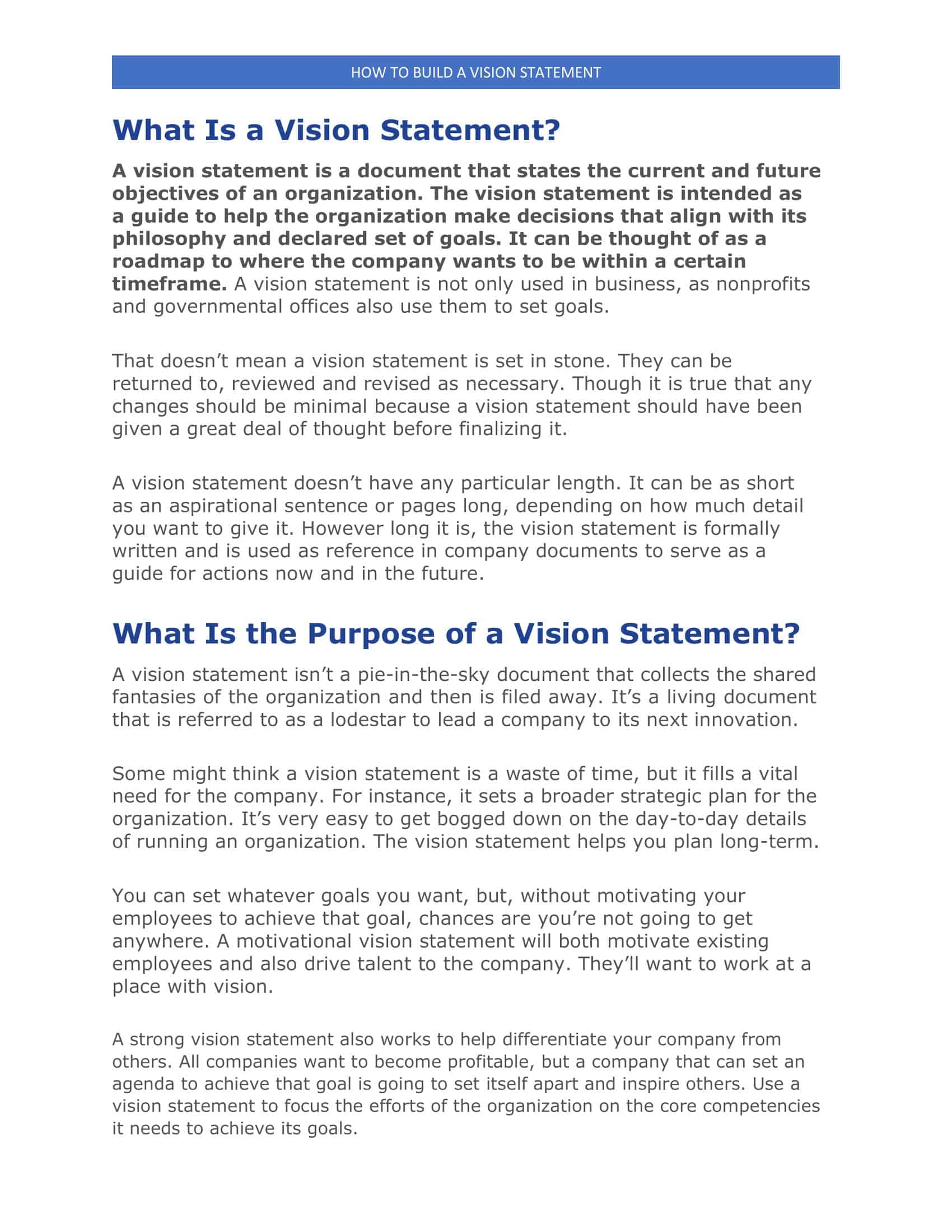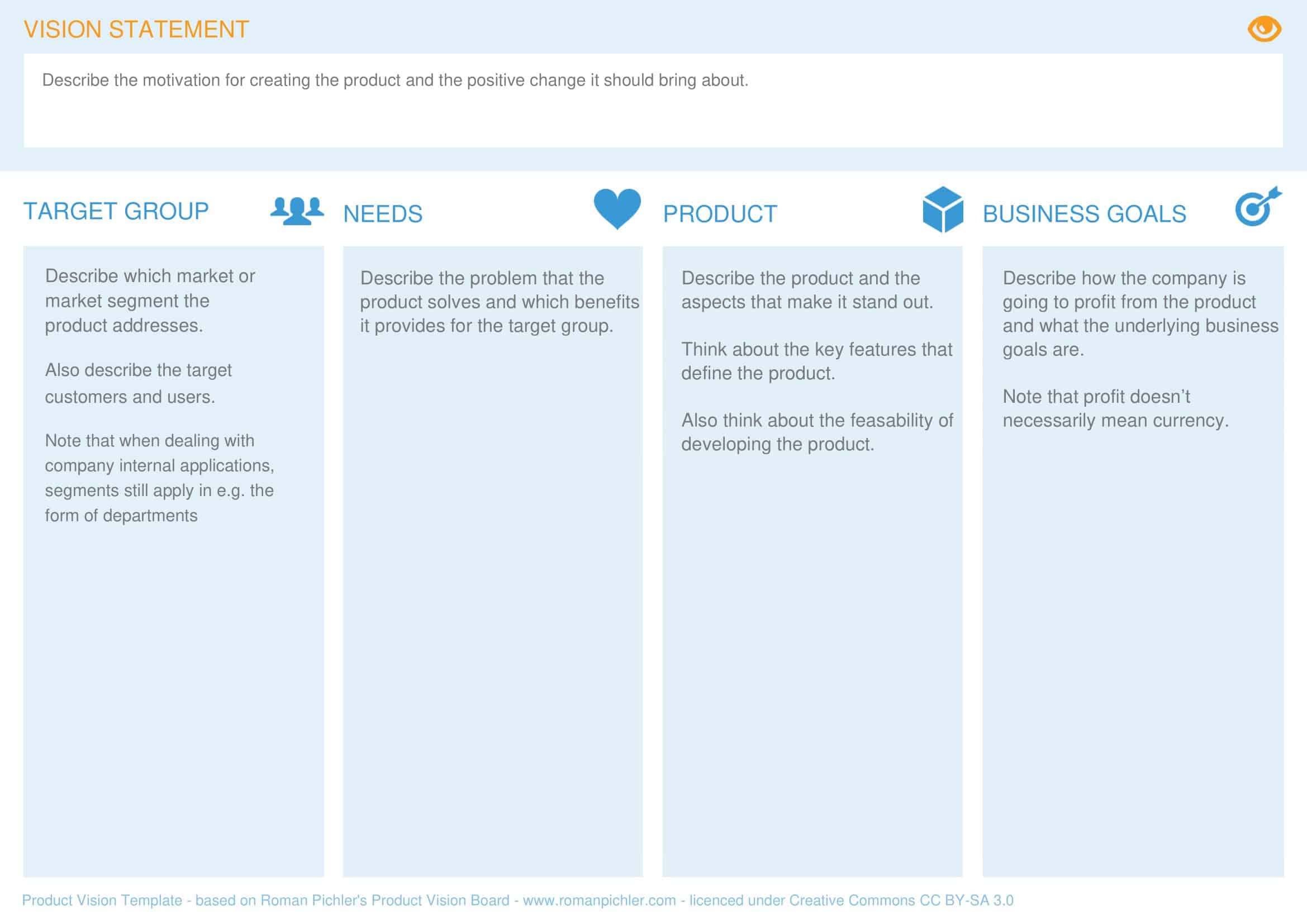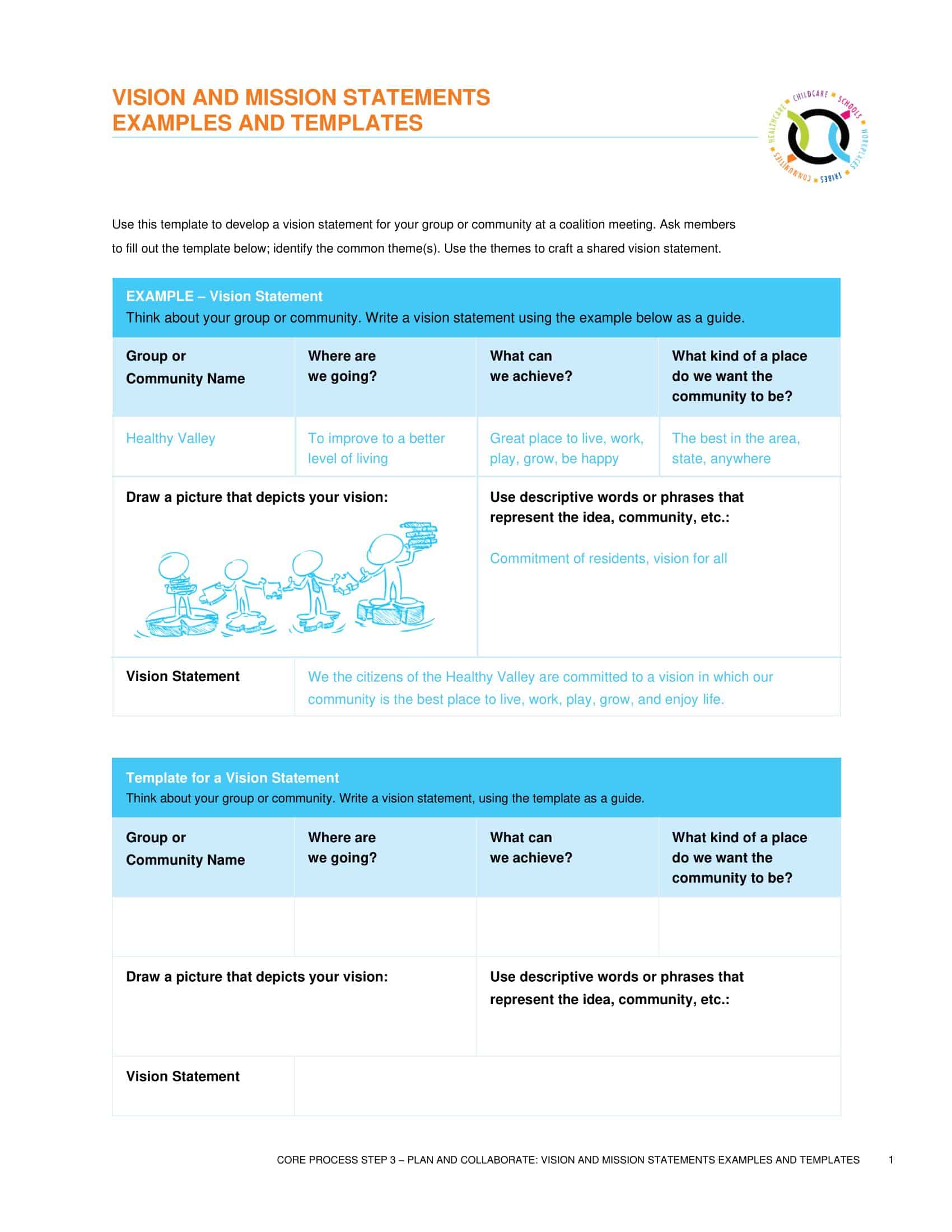A vision statement is a crucial aspect of any company and its importance cannot be overstated. Despite its brief length, crafting a comprehensive vision statement can prove to be a challenging task, even for the most seasoned of entrepreneurs. The vision statement serves as a roadmap, providing insight into the company’s identity, history, and aspirations for the future.
It serves as a concise representation of the company’s values, goals and objectives. By reading the vision statement, a reader should immediately gain a clear understanding of the company’s direction and purpose. To make the task of writing a vision statement easier, many companies turn to a vision statement template for guidance.
Table of Contents
Vision Statement Templates
Unlock your organization’s aspirations and define its future with our captivating collection of Vision Statement Templates. A vision statement is a powerful declaration that outlines the long-term goals, aspirations, and ideals of an organization. It serves as a guiding beacon, inspiring and aligning the efforts of team members towards a shared vision.
Our creatively designed and customizable templates provide a visually appealing canvas to craft a compelling vision statement that reflects your organization’s values, purpose, and desired impact. Whether you’re a startup, a nonprofit organization, or an established company, our templates offer a range of styles and formats to suit your unique brand identity and messaging. With our user-friendly templates, you can articulate a clear and inspiring vision, engage stakeholders, and motivate your team towards a common purpose. Empower your organization with a vision that fuels growth, innovation, and success using our versatile and easy-to-use Vision Statement Templates. Download now and create a vision that sets your organization on a path to greatness.
What is a vision statement?
![Free Printable Vision Statement Templates [Word, PDF] Examples 1 Vision Statement](https://www.typecalendar.com/wp-content/uploads/2023/05/Vision-Statement-1.jpg 1414w, https://www.typecalendar.com/wp-content/uploads/2023/05/Vision-Statement-1-212x300.jpg 212w, https://www.typecalendar.com/wp-content/uploads/2023/05/Vision-Statement-1-724x1024.jpg 724w, https://www.typecalendar.com/wp-content/uploads/2023/05/Vision-Statement-1-768x1086.jpg 768w, https://www.typecalendar.com/wp-content/uploads/2023/05/Vision-Statement-1-1086x1536.jpg 1086w)
A vision statement is a declaration of a company’s goals, values, and aspirations for the future. It serves as a guiding principle and sets the tone for the company’s direction and purpose. It provides a clear picture of what the company wants to achieve and how it wants to be perceived by its stakeholders. A well-crafted vision statement should inspire and motivate employees, provide a sense of purpose and direction, and serve as a benchmark for decision-making.
It also serves as a means of communication to both internal and external audiences, helping to define the company’s identity and set it apart from its competitors. Overall, a vision statement is a key component of a company’s long-term strategy and can play a significant role in its success.
What Is the Purpose of a Vision Statement?
The purpose of a vision statement is to serve as a guide for an organization’s future and provide direction for its decision-making. A well-crafted vision statement should:
Inspire and motivate employees: A clear and compelling vision statement can provide employees with a sense of purpose and direction, which can help to improve morale and boost motivation.
Communicate the company’s aspirations: A vision statement serves as a means of communication to both internal and external audiences, helping to define the company’s identity and set it apart from its competitors.
Provide direction for decision-making: A vision statement acts as a benchmark for decision-making, providing a clear understanding of what the company wants to achieve and how it wants to be perceived. This helps to ensure that all decisions align with the company’s long-term goals and values.
Establish a sense of purpose: A vision statement helps to provide a sense of purpose and direction for the company, serving as a roadmap for its future and helping to focus the organization’s efforts towards achieving its aspirations.
What are the parts of a mission statement?
A mission statement is a concise and inspiring statement that outlines an organization’s purpose, goals, and values. A well-crafted mission statement typically consists of the following components:
Purpose: A clear statement of the organization’s purpose and reason for existence, often referred to as its “raison d’être”.
Values: A description of the organization’s core values and beliefs, such as integrity, innovation, and customer service.
Products/Services: A description of the products or services offered by the organization and the benefits they provide to customers or clients.
Target market: A description of the organization’s target audience, including the customers or clients it serves.
Unique selling proposition (USP): A description of what sets the organization apart from its competitors and why it is unique.
Goals and objectives: A clear statement of the organization’s short- and long-term goals, such as increasing market share, expanding into new markets, or improving customer satisfaction.
Philosophy: A description of the organization’s approach to doing business, such as its commitment to sustainability, innovation, or community involvement.
Mission vs Vision Statement: What’s the Difference?
A mission statement and a vision statement are both important declarations that provide direction and purpose for an organization. However, there is a difference between the two:
Mission statement: A mission statement is a concise and inspiring statement that outlines an organization’s purpose, goals, and values. It focuses on the present and provides a clear understanding of what the organization does and why it exists. The mission statement serves as a roadmap for the organization’s actions and decisions, providing a clear picture of what the organization wants to achieve and how it wants to be perceived.
Vision statement: A vision statement is a declaration of an organization’s aspirations for the future. It sets the tone for the company’s direction and provides a clear picture of what the organization wants to achieve in the long term. The vision statement serves as a guiding light for the organization, inspiring employees and guiding decision-making. Unlike a mission statement, a vision statement is more focused on the future and often describes what the organization wants to be, rather than what it currently is.
In summary, a mission statement focuses on the present and provides direction for the organization’s actions and decisions, while a vision statement focuses on the future and provides inspiration and guidance for the organization’s aspirations. Both mission and vision statements are important components of an organization’s strategy and play a significant role in its success.
How to Write a Mission Statement
Writing a mission statement can seem like a daunting task, but with a few steps, you can create a clear and inspiring statement that provides direction and purpose for your organization. Here’s a step-by-step guide for writing a mission statement:
Step 1: Gather Input from Key Stakeholders
Before you begin writing your mission statement, it’s important to gather input from key stakeholders, including employees, customers, and other stakeholders who have a vested interest in the organization. This will ensure that your mission statement reflects the perspectives and priorities of all key stakeholders and provides a clear picture of what the organization is all about.
Step 2: Determine the Purpose of Your Organization
The first step in writing a mission statement is to determine the purpose of your organization. Why does it exist? What problem does it solve or what need does it meet? This will help you to understand the raison d’être of your organization and provide a clear understanding of what it does and why it exists.
Step 3: Identify Your Values and Beliefs
The next step is to identify your values and beliefs. What are the core principles that guide your organization’s actions and decisions? What do you believe in? This will help you to ensure that your mission statement reflects your values and beliefs and provides a clear picture of what is important to your organization.
Step 4: Determine Your Unique Selling Proposition
What sets your organization apart from its competitors? What makes it unique? Determining your unique selling proposition (USP) will help you to understand what makes your organization special and what sets it apart from others in your industry.
Step 5: Define Your Target Market
Who are your customers or clients? What needs do they have that your organization can meet? Understanding your target market will help you to ensure that your mission statement reflects the needs and perspectives of your customers and provides a clear picture of who you serve.
Step 6: Set Your Goals and Objectives
What are your short- and long-term goals? What do you want to achieve? Setting your goals and objectives will help you to ensure that your mission statement reflects your aspirations and provides a clear picture of what you want to achieve.
Step 7: Draft Your Mission Statement
With all the information gathered, it’s time to draft your mission statement. Start by answering the following questions:
- What does your organization do?
- Why does it exist?
- What problem does it solve or what need does it meet?
- What are your core values and beliefs?
- What sets your organization apart from its competitors?
- Who are your customers or clients?
- What are your goals and objectives?
With these questions in mind, write a draft of your mission statement. It’s important to keep your mission statement concise and easy to understand, using plain language that is accessible to all stakeholders.
Step 8: Refine Your Mission Statement
Once you have a draft of your mission statement, it’s time to refine it. Review it carefully and make any necessary changes to ensure that it accurately reflects the purpose, goals, and values of your organization.
Step 9: Get Feedback
Get feedback on your mission statement from key stakeholders, including employees, customers, and other stakeholders who have a vested interest in your organization. Use their feedback to make any final changes to your mission statement and ensure that it accurately reflects the perspectives and priorities of all stakeholders.
Step 10: Finalize and Communicate Your Mission Statement
Once your mission statement is complete, it’s time to finalize it and communicate it to your stakeholders. Make sure that your mission statement is widely distributed and that all employees and stakeholders are aware of it. This will help to ensure that everyone is working towards the same goal and that your mission statement becomes a guiding principle for the organization.
Step 11: Incorporate Your Mission Statement into Your Operations
Finally, it’s important to incorporate your mission statement into your daily operations. Use it to guide decision-making, set priorities, and measure success. Make sure that your mission statement is visible and accessible to all employees, and that it is regularly reviewed and updated as needed.
What makes a good vision statement?
A good vision statement should have the following characteristics:
Inspiring: A good vision statement should be inspirational and motivate people to work towards a common goal. It should paint a picture of a better future and provide a reason for why the organization exists.
Clear and concise: A good vision statement should be clear, concise, and easy to understand. It should communicate the organization’s purpose and goals in a straightforward and simple manner.
Unique: A good vision statement should be unique and set the organization apart from others in its industry. It should reflect the organization’s values, beliefs, and goals and provide a clear picture of what it stands for.
Forward-looking: A good vision statement should be forward-looking and provide a picture of the organization’s future. It should set a clear direction for the organization and inspire people to work towards a better future.
Actionable: A good vision statement should be actionable and provide guidance for the organization’s future. It should be used to set priorities, guide decision-making, and measure success.
Relevant: A good vision statement should be relevant and aligned with the organization’s current and future goals. It should reflect the needs and perspectives of all stakeholders and provide a clear picture of the organization’s future.
Timeless: A good vision statement should be timeless and not be limited by current trends or circumstances. It should provide a long-term view of the organization’s future and remain relevant for years to come.
Vision Statement Examples
Here are some examples of well-known vision statements:
Nike: “To bring inspiration and innovation to every athlete in the world.”
Walmart: “To save people money so they can live better.”
Coca-Cola: “To refresh the world. To inspire moments of optimism and happiness.”
Amazon: “To be Earth’s most customer-centric company, where customers can find and discover anything they might want to buy online.”
Tesla: “To accelerate the world’s transition to sustainable energy.”
Google: “To organize the world’s information and make it universally accessible and useful.”
Microsoft: “To empower every person and every organization on the planet to achieve more.”
Apple: “To design and develop tools that enhance and simplify people’s lives.”
Disneyland: “To create happiness by providing the finest in entertainment for people of all ages, everywhere.”
FedEx: “To be the world’s most reliable and cost-effective provider of transportation and e-commerce solutions.”
FAQs
How often should a vision statement be updated?
A vision statement should be reviewed and updated as needed to ensure that it remains relevant and aligned with the organization’s goals and aspirations. It is generally a good idea to review a vision statement every 2-5 years to ensure that it remains current and relevant.
How can a vision statement be used in an organization?
A vision statement can be used in an organization to guide decision-making, set priorities, and measure success. It should be incorporated into the organization’s operations and used to inspire and motivate employees, stakeholders, and decision-makers. A vision statement can also be used to communicate the organization’s aspirations and goals to the public and other stakeholders.
Can a vision statement be too long?
A vision statement should be short, concise, and easy to remember. If a vision statement is too long, it may be difficult for employees, stakeholders, and the public to understand and remember. A good vision statement is typically no more than a few sentences in length.
Who should be involved in writing a vision statement?
Writing a vision statement should be a collaborative process that involves employees, stakeholders, and decision-makers. This helps to ensure that the vision statement reflects the aspirations and goals of the organization as a whole, and that everyone is aligned and motivated by the same purpose.
How can a vision statement be communicated to employees and stakeholders?
A vision statement can be communicated to employees and stakeholders through various means, such as company-wide meetings, company communications, company websites, and company marketing materials. It is important to communicate the vision statement regularly to ensure that everyone is aware of it and motivated by it. Additionally, incorporating the vision statement into the organization’s operations and using it as a guide for decision-making and priority setting can also help to ensure that it is effectively communicated and implemented.













































![Free Printable Landlord Statement Templates [Word, PDF, Excel] Example 2 Landlord Statement](https://www.typecalendar.com/wp-content/uploads/2023/05/Landlord-Statement-150x150.jpg)
![Free Printable Roommate Agreement Templates [Word, PDF] 3 Roommate Agreement](https://www.typecalendar.com/wp-content/uploads/2023/06/Roommate-Agreement-150x150.jpg)
![Free Printable Credit Card Authorization Form Templates [PDF, Word, Excel] 4 Credit Card Authorization Form](https://www.typecalendar.com/wp-content/uploads/2023/06/Credit-Card-Authorization-Form-150x150.jpg)
